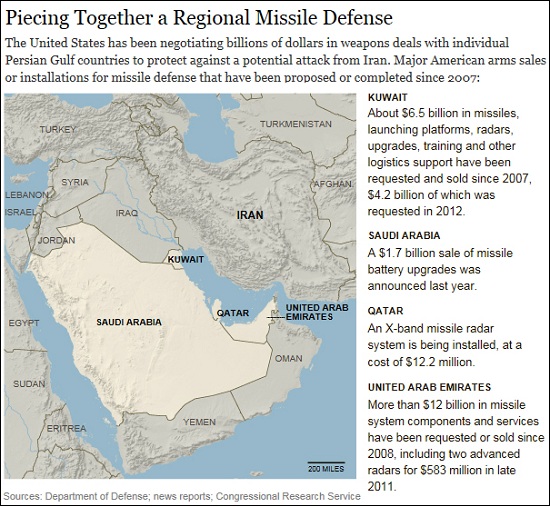
|
|

|
|
| April 19, 2024 |
|
U.S. and Gulf allies pursue a missile shield against Iranian attack 
WASHINGTON--The United States and its Arab allies are knitting together a regional missile defense system across the Persian Gulf to protect cities, oil refineries, pipelines and military bases from an Iranian attack, according to government officials and public documents.
It is an enterprise that is meant to send a pointed message to Tehran, and that becomes more urgent as tensions with Iran rise. But it will require partner nations in the gulf to put aside rivalries, share information and coordinate their individual arsenals of interceptor missiles to create a defensive shield encompassing all the regional allies. Secretary of State Hillary Rodham Clinton, among the first to raise the need for the missile shield three years ago, sought to spur the gulf allies on during a recent visit to Saudi Arabia. “We can do even more to defend the gulf through cooperation on ballistic missile defense,” she said during a session in March of the Gulf Cooperation Council, which includes Bahrain, Kuwait, Oman, Qatar, Saudi Arabia and the United Arab Emirates. “Sometimes to defend one nation effectively you might need a radar system in a neighboring nation,” she said, adding, “But it’s the cooperation, it’s what they call ‘interoperability’, that we now need to really roll up our sleeves and get to work on.” That would include deploying radars to increase the range of early warning coverage across the Persian Gulf, as well as introducing command, control and communications systems that could exchange that information with missile interceptors whose triggers are held by individual countries. For that purpose, the Pentagon late last year announced a contract for the sale of two advanced missile defense radars to the United Arab Emirates. And early this year, officials disclosed that a similar high-resolution, X-band missile defense radar would be located in Qatar, as well. The objective in the gulf is shared by a more widely publicized missile defense shield being installed in Europe: to deter any Iranian attack and, if required, to blunt the effect of missiles launched against allied territory and American forces. But the similarities end there. The administration’s European initiatives have been embraced by NATO and are being put into place after formal negotiations with countries that will host early warning radars, ground-based interceptors and Navy warships equipped to track ballistic missiles and shoot them down. In contrast, the Persian Gulf effort is mostly behind the scenes, and on a country-by-country basis, with billions of dollars in arms sales negotiated bilaterally between the United States and nations in the region. Thus, the next challenge is coaxing gulf nations to put aside their rivalries and share early warning radar data, and then integrate the capabilities of their unilateral missile interceptor systems to extend defenses over the entire region. While officials would not provide a full list of the weapons sales, a study of the public record, Defense Department contract announcements, foreign arms transfer notifications required by law and studies conducted for Congress, offered a detailed picture of the American initiatives. If the planned European missile defense system is growing from a full engineering blueprint, the approach in the Persian Gulf is more like assembling a jigsaw puzzle. And with the latest arms sales, important pieces are coming together that, when connected, will bring toward fruition a project that American officials have pursued for years. Three weeks ago the Pentagon announced the newest addition to Persian Gulf missile defense systems, informing Congress of a plan to sell Kuwait $4.2 billion in weaponry, including 60 Patriot Advanced Capability missiles, 20 launching platforms and 4 radars. This will be in addition to Kuwait’s arsenal of 350 Patriot missiles bought between 2007 and 2010. The United Arab Emirates acquired more than $12 billion in missile defense systems in the past four years, documents show. In December, the Pentagon announced a contract to provide the Emirates with two advanced missile defense launchers for a system called the Terminal High Altitude Area Defense, valued at about $2 billion, including radars and command systems. An accompanying contract to supply an arsenal of interceptor missiles for the system was valued at another $2 billion, according to Pentagon documents. Saudi Arabia also has bought a significant arsenal of Patriot systems, the latest being $1.7 billion in upgrades last year. The United States’ own military forces provide a core capability for ballistic missile defenses in the Persian Gulf, in particular the American Navy vessels with advanced tracking radars and interceptor missiles. According to Navy officials, these Aegis missile defense systems, carried aboard both cruisers and destroyers, are in the region on continuous deployments. And the United States has deployed a number of land-based missile defense systems to defend specific American military facilities located around the gulf. Even so, the challenges to creating an integrated regional missile defense system are both technological and political. On the technical side, no missile defense system can promise 100 percent effectiveness. And the task is made more difficult by the fact that the capability emerging in the Persian Gulf is more ad hoc than the carefully designed architecture for Europe. Also, Iran is increasing both the type and number of missiles it is fielding. Political challenges stem from historic rivalries, prompting the Persian Gulf partner nations to enhance their security through bilateral relationships with the United States. And while all six members of the Gulf Cooperation Council share concerns over Iran, all have resisted multilateral security initiatives. (Source: The New York Times) Story Date: August 10, 2012
|